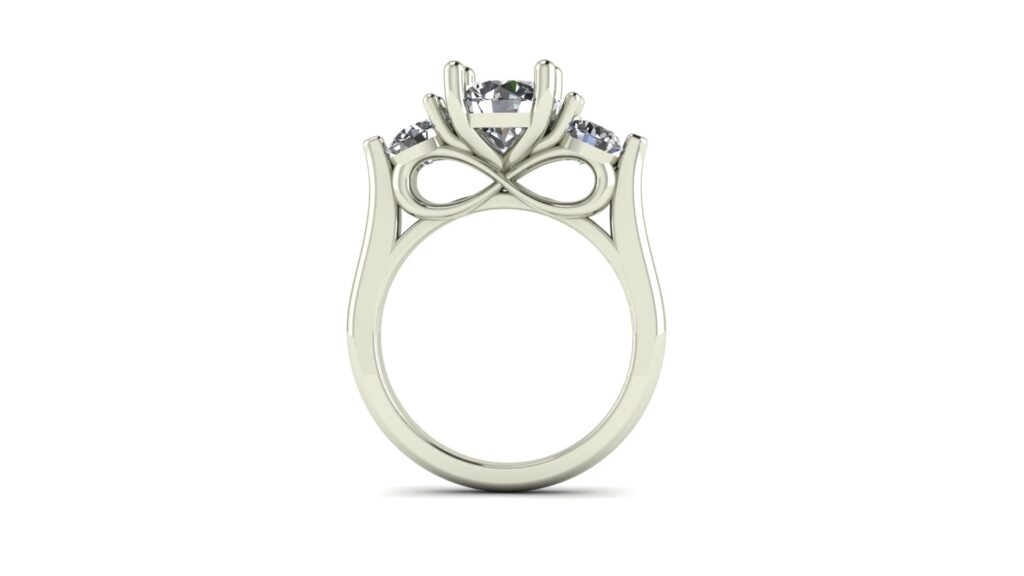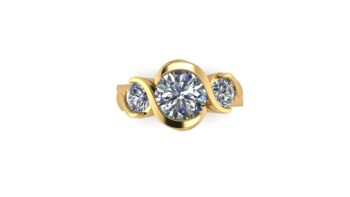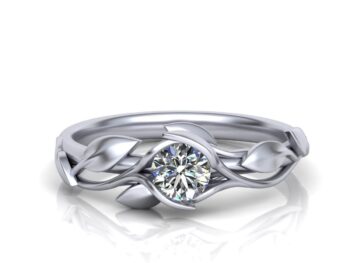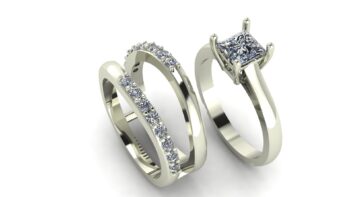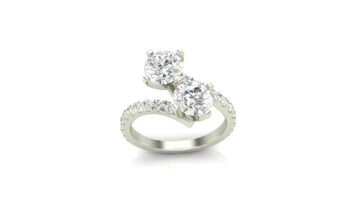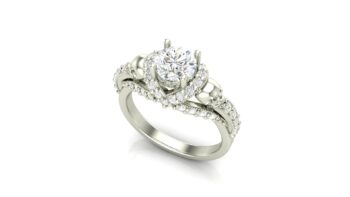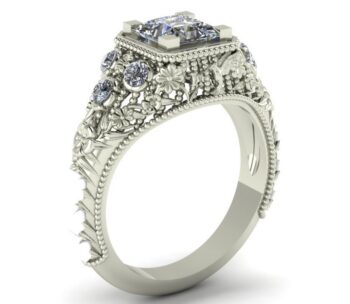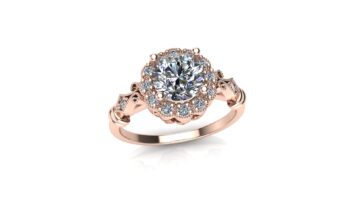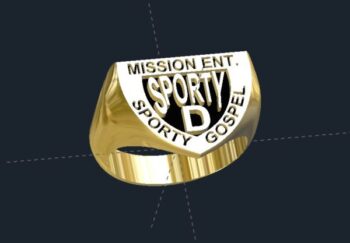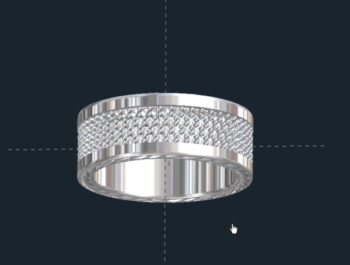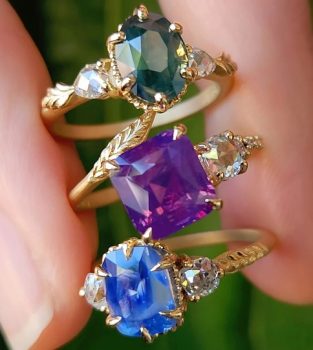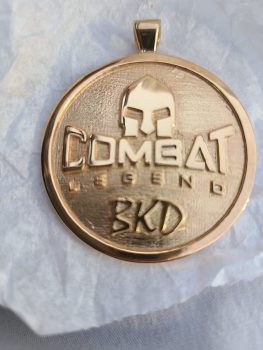If you are a bride to be, are you considering Lab Grown Diamond Engagement Rings? Lab grown diamonds have been around for around 70 years. However, they really
haven’t taken off in popularity until the last 5 years or so. And they have really gained in popularity over the last 2 years as prices have dropped dramatically. Debeers,
long the monopoly holder on natural diamonds, entered the lab grown diamond arena and sent prices tumbling. They also created far more visibility and demand for Lab
Grown Diamond Engagement Rings than ever before. And this is a good thing as now many more can afford a diamond rather than having to go with a diamond simulant
like Moissanite. HERE is a brief history of how the stones that go into Lab Grown Diamond Engagement Rings were first created.
This is our 3 stone bezel set engagement ring. We like this one because of the flow of the bezels. The 2 pieces forming the bezel for the center stone also help to form the bezels for the side stones.
Lab Grown Diamond Engagement Rings
Are you trying to get the most bang for your buck out of your engagement ring budget? You’ve might have seen in your research that lab diamonds are everywhere and far
more affordable for a comparable natural stone. But how to natural diamonds compare to lab grown? Are they as durable? Fiery? What about their resale value?
There are still a lot of questions about Lab Grown Diamond Engagement Rings due to the historical scoffing at lab diamonds by the “established” diamonds companies like
Debeers. There is also a lot of disinformation. Because they’re called synthetic diamonds, many people don’t even think they are a real diamond. Or, they understand the
lab part but not the similarities between the two.
Natural diamonds and lab-created diamonds have the exact same physical and chemical properties, so they are every bit the same gemstone. Think of a name brand drug
vs a generic one. They are identical to each other. The main difference with lab grown diamonds is in how is how they are created.
Here’s an easy chart showing how natural and lab diamonds differ (and are the same), and their pros and cons.
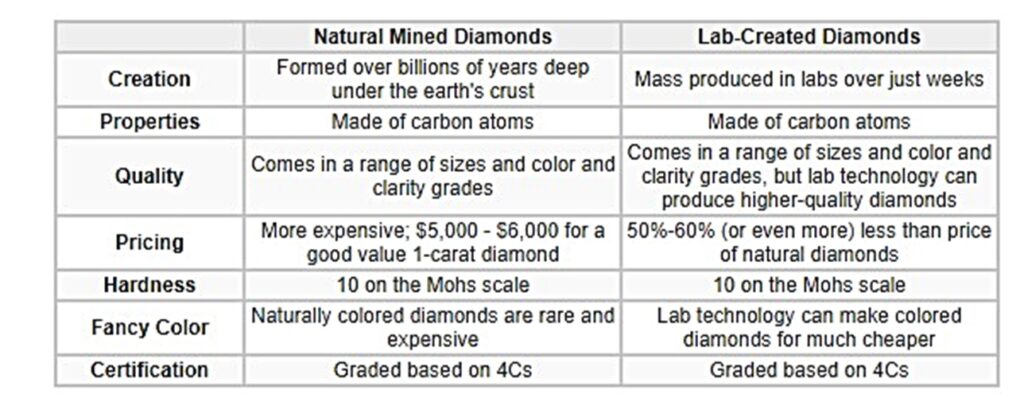
Do Lab Diamonds Look Like Natural Diamonds?
Because Lab Grown Diamond Engagement Rings have the same physical and chemical properties as natural diamonds, they are almost impossible to discern one from the
other. Lab-created diamonds reflect light in the same way as natural ones. They also have the same brilliance, fire, and durability as natural diamonds.
Even a GIA graduate gemologists cannot tell the difference between the just by looking at it even with a microscope. Specialized machines are required to pick a lab stone
vs a natural diamond. GIA has a of tool that can distinguish between natural diamonds, diamonds, and simulants using spectroscopic technology. But at $5700, it is not
something the consumer or even jewelers would buy. The easiest way to identify a lab grown diamonds is to look for a laser inscription. Legitimate lab that certify
diamonds will laser engrave a small serial number on the girdle that will identify the stone as a lab diamond. But you won’t be able to see this engraving without very high
magnification, so a trip to the jeweler is required to identify a lab stone at the least.
This is our tension set floral engagement ring. There are leaves and vines growing uo towards the center stone, which is held in place by leaves.
Pros and Cons Of Lab Grown Diamond Engagement Rings
Pros:
- Can be over 60% cheaper than natural stones.
- Enables you to get a larger stone for the same cost.
- Colored lab diamonds are also available of you want a colored stone engagement ring.
- Much more environmentally sustainable
- No child labor or “blood diamond” issues.
- Made in labs with fair wages
Cons:
- These are made in a lab and so are not rare like natural stones can be.
- If you can even resell the stone, it will be at a fraction of what you paid retail.
- Growing lab diamonds requires a lot of energy.
In looking at the cons, it is easy to see why so many are going with Lab Grown Diamond Engagement Rings. Many do not care that the stone is made in a lab or they
require a lot of energy to produce. The resale value can be an issue for some, especially if you plan on upgrading the center stone at some point in the future. However,
many counter that with the fact that larger stone can be bought in the first place because of the far lower cost.
This is a simple solitaire engagement ring that we have created an enhancer for. It goes in the center of the enhancer forming a bridal set. We like this one because of the diametrically opposed on the enhancer.
Pros And Cons Of Natural Diamond Engagement Rings
Pros:
- Each diamond is unique, like a snowflake.
- Natural diamonds are a high end and luxury item.
- Have a higher resale value than Lab Grown Diamond Engagement Rings
- Many jewelers advertise trade in policies where you can upgrade your existing stone.
Cons:
- Cost much more than lab grown diamonds.
- Environmentally more invasive
- Come with social issues like child labor and “blood diamond” reputation.
Unlike Lab Grown Diamond Engagement Rings, natural stones have cons that are much harder to ignore. The cost is the main problem. With a decent stone costing
thousands of dollar per carat, Lab Grown Diamond Engagement Rings really are attractive in comparison. And if anyone who cares about the environment has seen a
diamond mine, it is obvious they aren’t good for it. Additionally, it is tough to imagine an 8 year old kid being forced to work in a mine for pennies a day so you can have a
sparkly stone on your finger. Still, it has been engrained in consumers’ heads for decades that lab diamonds are inferior, so natural stones are still the favorite.
This is one of your 2 stone engagement rings. These have become popular in recent years as the 2 stones can represent the husband and wife. Also, you get a lot of stone with the bypass design, allowing for large stones.
Should You Buy a Lab Grown Stone?
So, now that we have established that lab diamonds are identical to natural ones, which is best for you? It depends on a few things. Budget is the main thing to consider,
but for some, the price difference isn’t the reason they choose Lab Grown Diamond Engagement Rings.
Lab Grown Diamond Engagement Rings are for you if:
- You are looking for size in your center stone or stones.
- You prefer the more ethical process of growing a diamond in a lab over mining them from the Earth.
- You don’t want to support the diamond mining industry.
- You have no plans to upgrade the stones or if you do not care about the resale value.
Natural Diamond Rings are for you if:
- You think a stone should be created in the earth an dnot a mine.
- You aren’t interested in the largest stone your budget will afford.
- If you plan on trading up or selling your diamond in the future.
As you can see, there is no right or wrong answer. For some, natural diamonds are the way to go. For others, Lab Grown Diamond Engagement Rings make more sense.
We advise you to sit down with your partner and decide which choice is the best for you as a couple.
This is one our skull engagement rings that you would think never sells. Wrong! Skulls are a very popular motif for engagement rings. We have quite a few skull ring designs that are bought by people who don’t look like they would be wearing skulls.
How Lab Diamonds Are Created
Natural diamonds are unique because they were created over billions of years and that no two are the same. Far beneath the surface of the planet, extreme heat and
pressure turned loose carbon atoms into diamonds. Through seismic eruptions, they are then pushed out closer to the surface. Once discovered, the stones are then mined,
cut, and polished to become what you see on someone’s finger, ears or chest.
Lab diamonds are grown simulating the same conditions, but in a lab setting. A tiny diamond “seed” is set in a space where heat and pressure begin to form the stone. This
process only takes a few weeks vs the millions of years it takes to form a natural stone. However, the result is the exact same as what the earth creates: one of the hardest
stones on the planet that can be polished into a stunning and fiery gem.
This is our art deco hummingbird engagement ring. Using CAD and lost wax casting, we can create almost anything you can dream up. If you are looking for Lab Grown Diamond Engagement Rings, but don’t want a cookie cutter ring from the mall, contact us.
Pricing For Lab Grown Diamond Engagement Rings
The price of lab diamonds has dropped considerably in the last couple of years because DeBeers began growing and selling them. This was a very interesting development
for the industry because until then, the big players had scorned lab diamonds. Since then, prices have dropped vs what they cost when they were first being sold. Lab
Grown Diamond Engagement Rings can now cost up to 80% less than engagement rings with natural diamonds in them. Here is a breakdown prices G color and VS1
clarity diamonds.

As you can see, the savings of Lab Grown Diamond Engagement Rings are pretty high with a 1 carat center stone. But then, when you get to the 2 carat, the saving really
become pronounced and you can see why Lab Grown Diamond Engagement Rings are becoming so popular.
This is one of our Vintage Halo Engagement Rings. We also have it with an oval shaped center stone. Some might think it is a little busy with all the different design elements, but we don’t. And that is the awesome thing about custom jewelry. It doesn’t matter what anyone else thinks. It is your ring. So get what you want!
Are Lab Diamonds As Durable as Natural?
We’ve all heard the ubiquitous saying that diamonds are forever. However, are lab diamonds forever as well? Since Lab Grown Diamond Engagement Rings posses
identical physical and chemical properties as natural stones, they have the same durability. Both rate 10 on the Mohs hardness scale, which is the hardest gemstone you
can get. Consequently, lab diamonds will never become scratched and cloudy. However, lab diamonds can still chip or shatter due to being struck if the impact is in a
cleavage plane. So, as with any expensive piece of jewelry, lab diamonds still require a careful touch. However,with a little awareness, your lab diamond should last just as
long as if it was mined from the earth.
Give Us A Shot!
Do you love the style of a ring but it inly comes with a shape of stone that you don’t want? Are you happy with the the design of the top half of the ring, but don’t like the
bottom half. If that describes you, we can help!!! How can we help?? The answer lies in creating a custom engagement ring that is totally made to your specs. We will help
you to create one from scratch if that is what it takes to make your dream a reality. Instead of going for mass produced pieces, we can help you transform your own idea
into reality.
While custom engagement rings are one of our specialties, we don’t limit ourselves to that! Regardless of whether it is a wedding band, pendant, or bracelet, we can make
anything.
You can view our portfolio of custom engagement rings to look for ideas. Or you can contact us with your own idea for Custom Lab Grown Diamond Engagement Rings. It can cost less than you think to have your very own custom engagement ring made,
especially with the lab grown diamond prices dropping. Why settle for boring, uninspiring, mass-produced engagement rings from the mall? We can make exactly what
you want as long as it is a workable design. Don’t see what you are thinking about for your unique engagement ring? Send us the design you want and we will bring it to
life.
